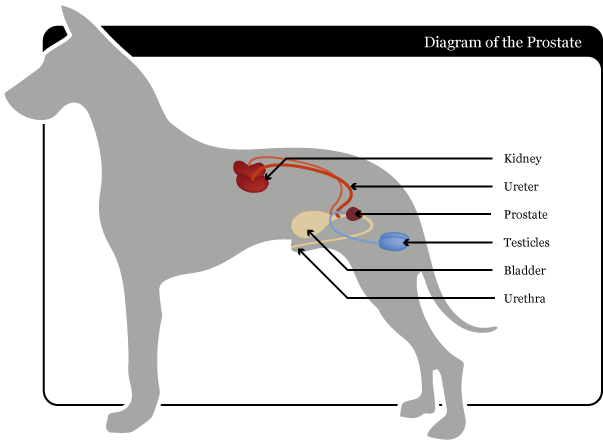Just like men, male dogs can develop prostatic disease, including prostate cancer. This disease tends to be fairly aggressive in our canine companions, and thus early identification is of paramount important. For this reason, I’ve dedicated this week’s post to raising awareness about prostate cancer in dogs. I hope you find this information helpful and shareworthy. Don’t forget to review my previous post that provides general data on prostatic diseases. Happy reading!

Prostate Cancer – What causes it?
The first step to understanding prostate cancer is having a basic understanding of the prostate gland itself. The prostate is part of a male dog’s reproductive tract. It wraps around the urethra (tube that connects the urinary bladder to the outside world) near the neck of the urinary bladder. The prostate produces seminal fluid that provides nutrients to promote sperm metabolism and survival in the female reproductive tract.

We don’t fully understand what causes prostate cancer. In men, the development of prostate cancer depends on androgens (sex hormones like testosterone). In contrast, this disease in dogs doesn’t depend on such an influence. In fact, prostate cancer is most commonly documented in neutered dogs, and some have proposed androgens confer an anti-proliferative effect on prostatic tissue. Prostate cancer makes up 5-7% of all prostatic diseases.
Prostate Cancer – What does it look like?
As mentioned earlier, prostate cancer is more common in castrated patients than intact ones. Additionally, this cancer is more frequently documented in middle-aged and older patients than young ones; the average age of onset in 10 years of age. Some breeds are over-represented for prostate cancer, including:
- Beagles
- Doberman pinschers
- English springer spaniels
- Scottish terriers
- Shetland sheepdogs
- Bouvier des Flandres
- German shorthair pointers
- West Highland white terriers
- Airedale terriers
- Norwegian elkhounds

Common clinical signs associated with prostate cancer include:
- Pollakiuria (urinating only small amounts of urine)
- Dysuria (painful urination)
- Hematuria (blood in urine)
- Tenesmus (straining to defecate)
- Dyschezia (painful defecation)
- Pelvic limb weakness and/or lameness
- Lethargy
- Reduced (or loss of) appetite
- Weight loss
- Hemorrhagic discharge from the penis
- Spinal (lumbar) discomfort
Prostate Cancer – How is it diagnosed?
After obtaining a thorough history, a veterinarian will perform a complete physical examination including a rectal examination. In most patients, rectal examination reveals an irregularly enlarged, non-painful enlarged prostate (called prostatomegaly). In some large and giant breeds, the prostate gland is not palpable via rectal examination.
A veterinarian will recommend some non-invasive blood and urine tests, as well as diagnostic imaging studies, including:
- Complete blood count – to evaluate white blood cells, red blood cells, and platelets
- Biochemical profile – to check electrolytes (i.e.: sodium, potassium), as well as liver and kidney values
- Urinalysis – to screen for evidence of inflammation & infection, as well as help evaluate kidney function
- Urine culture – to definitively screen for a urinary tract infection
- Diagnostic imaging (i.e.: radiographs/x-rays, abdominal sonography, computed tomography/CT scan)
If diagnostic imaging confirms prostatomegaly, a prostate sampling procedure will be recommended. Methods for sampling cells from the prostate gland are:
- Cytology – cells may be obtained from the prostate either via aspiration or a minimally invasive procedure called a prostatic wash
- Biopsy – a surgical procedure to obtain a “chunk” of tissue for evaluation; more invasive than an aspiration or prostatic wash
Pet parents will likely find it helpful to partner with a board-certified veterinary internal medicine specialist to develop a logical and cost-effective diagnostic plan.
Prostate Cancer – How is it treated?
There are many modalities available to treat prostate cancer. However, there is no uniform standard of care, and no treatment modality is curative. Treatments available are:
- Surgery – performed to remove all or part of the prostate gland and tumor
- Radiation therapy
- Chemotherapy – several drugs have been used to help treat prostate cancer
- Photodynamic therapy – involved the use of a light, oxygen, and photosensitizing drug to damage tumor cells
- Non-steroid anti-inflammatory drug (NSAID) therapy – some NSAIDs (i.e.: piroxicam, carprofen, meloxicam) have anti-tumor effects for prostate cancer
Other interventions – often called salvage procedures – have been performed. None directly treat prostate cancer but they can temporarily improve patient comfort. The procedures are:
- Urethral stenting – a special device that helps maintain patency of the urethra so urine can flow from the urinary bladder to the outside world
- Cystostomy tube – a permanent tube placed in the urinary bladder that passes through the body wall to bypass the prostate and urethra. Pet parents have to intermittently open the tube to allow their dog to urinate
Pet parents are strongly encouraged to partner with a board-certified veterinary oncologist (cancer specialist) to develop the most appropriate treatment plan for their fur baby. Unfortunately, the prognosis for prostate cancer is usually poor. The median survival time with multimodal therapy (i.e.: chemotherapy + NSAID) is ~5-7 months.
The take-away message about prostate cancer in dogs…
Prostate cancer is an aggressive disease is male dogs. Neutered dogs are more often affected and may show signs like abnormal urination. Early identification is of paramount importance so aggressive therapies may be initiated promptly.
To find a board-certified veterinary internal medicine specialist, please visit the American College of Veterinary Internal Medicine.
To find a board-certified veterinary oncologist (cancer specialist), please visit the American College of Veterinary Internal Medicine.
Wishing you wet-nosed kisses,
CriticalCareDVM





